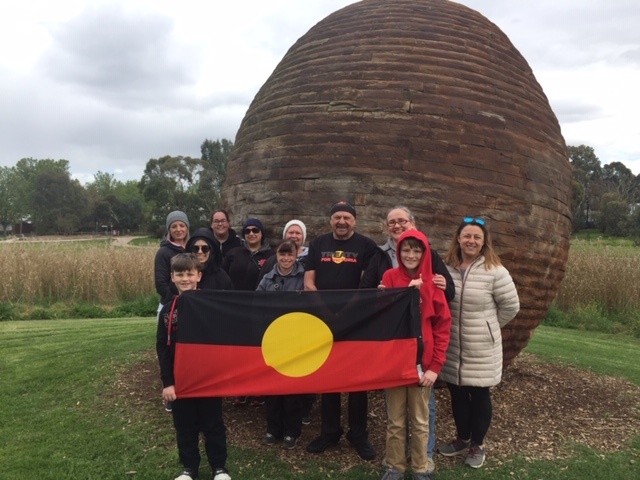Melbourne services use Innovative Solutions fund to embed Aboriginal perspectives

A group of services in the northern suburbs of Melbourne have used the Innovative Solutions Fund to help embed Aboriginal perspectives. In this piece the Victorian Inclusion Agency speaks to the director of Wood Street Childcare Centre, Vanessa Lucantonio, to learn more.
Your centre recently partnered with three others to apply for Innovative Solutions funding – why?
Originally, we began the process of applying for Innovative Solutions funding by ourselves, but we were finding it very difficult to successfully engage with Aboriginal organisations – and to get the application completed! During a local education and care network meeting with the City of Darebin, the idea to expand the project to include other centres was discussed. Faye Sakaris from the Victorian Inclusion Agency and Margaret Phillips from the City of Darebin lent their support to make the group application happen. The project partners were us, Happy Hubbub, Darebin Childcare and Kindergarten Preston and Darebin Childcare and Kindergarten Reservoir.
What barriers were you seeking to overcome through the project?
Essentially we wanted our services to be more inclusive and welcoming. All four centres have been unsuccessful in attracting Aboriginal families with some families suggesting our services were too ‘white’. Despite reading a range of material about Aboriginal perspectives, we still felt really unsure about how to really embed them in the everyday. We felt this uncertainty was a barrier to the meaningful inclusion of Aboriginal children in our services.
We had three key goals:
- For educators to develop knowledge, skills and confidence about Aboriginal perspectives, the impact of colonisation and intergenerational trauma, and strategies to facilitate a trauma-informed environment for all children;
- For all four services to develop lifelong partnerships with Aboriginal-controlled organisations to promote, attract and retain Aboriginal families in our early learning services; and,
- For our educators to gain skills to enable knowledge exchange with families and children to promote a more equitable society for Aboriginal people.
What were the benefits of applying for funding as a group? How did you approach the application process and what were the challenges?
To apply we had to develop a business case. This involved critically reflecting on barriers to the inclusion of Aboriginal families at our centres, sourcing a quote from a reputable supplier and collaborating on a project plan. We also needed to work out what outcomes we expected as a result of the project.
The business case took quite a while to complete – but the Victorian Inclusion Agency helped and supported us to complete it. Collaborating with other centres gave us a louder voice and opened the door for the local council and other institutions to help us navigate our way through the process and provide support and encouragement. It also motivated us to keep going! Working as a group of centres gave us more ideas, took us on different paths and the project was better because of it. Our community was broadened and we developed deeper relationships with our partners.
Your group Innovative Solutions application was the first of its kind to be accepted in Victoria. What did you use your funding for?
Essentially, to connect with an Aboriginal elder for mentoring and to get the families from each centre involved in the centres’ reconciliation journeys. We connected with local Elder Uncle Trevor Gallagher and organised for him to visit each centre four times over the next year. During his visits, we sought feedback on current set-ups and practices, and asked for advice on how we could embed best cultural practices.
We also established biannual yarning circles – one for educators and another for families – led by Uncle Trevor. Our first yarning circle for families was outstanding. A huge interest meant we had to hold it at a nearby park. More than 80 families attended – it became a picnic event with families being able to engage in meaningful conversations with Uncle Trevor. The families especially loved being a part of the smoking ceremony which kicked off the yarning circle and picnic. For most families this was the first time they had the opportunity to engage in such an event.
We also purchased learning resources for educators.
How did Faye, your Inclusion Professional from Community Child Care Association, help?
Faye was amazing throughout the whole process. She helped us develop and implement our plan and continued to connect with the services throughout the year-long journey. She gave us a checklist of reflections and questions to ask Uncle Trevor to enable us to get the most out of our engagement. She also continually asked thoughtful questions to deepen our critical reflection through the project.
What did you learn through this project?
Being able to speak with Uncle Trevor about our fears of ‘teaching the wrong thing’, or being ‘tokenistic’ in our teachings, gave all educators the confidence in what they were doing.
Probably the biggest lesson we all learnt along the way is understanding that the land is a link between all aspects of Aboriginal people’s existence – spirituality, culture, language, family, law and identity. Indigenous people believe that the land is for everybody. The land welcomes all people and offers us its provision. However, we are required to respect the land in return. The concept of honouring this relationship has always been central to the teachings at Wood Street, so the biggest lesson our centre learnt was that in many respects we were already embedding Aboriginal perspectives within our teachings without recognising that this was occurring.
Because the program spanned 12 months, our understanding deepened over time and the teachings provided by Uncle Trevor took on new meanings throughout the length of the project.
How has the funding made a difference to children and their families in the four services?
We learnt to not be afraid to try! By embedding things naturally into our everyday practices, such as books, songs, natural play resources and rituals – such as a daily acknowledgement – and having posters and talking with our children about Indigenous culture, history and current successes, we were able to achieve a lot.
From the beginning, we took our families along on this journey. We thought it was important to include them as this would contribute to a more positive outcome for all. Along the way, we provided them with historical information and created opportunities for them to connect with events being held within our area as well as providing teachings from an Indigenous perspective. For many of our families, this was the first time they had been provided with this opportunity.
Many families reported that they have been inspired to undertake their own journeys to educate themselves about Aboriginal history. One family is now doing an Acknowledgement of Country at home, instigated by their child!
How has this Innovative Solutions project made a difference to educators and inclusive practice at your centres?
This project has reinforced our notions that all children deserve to be members of an equitable society and we continue to advocate for their rights. Above all, the project has given our educators confidence and we now have a deep ongoing relationship with Uncle Trevor.
What advice would you give to services looking to follow your lead? Do you have any tips?
- Work out what barriers to inclusion your service is facing.
- Design a project that will help you break down those barriers.
- Involve your inclusion agency from the start – get help from them if you are uncertain where to access quotes from.
- Consider doing a group project. Find others who want to go on a journey with you with a shared vision and you will be taken somewhere else and achieve more!
The Innovative Solutions Support Funding has been created to fund innovative solutions to inclusion barriers, and can be used to support:
- children with challenging behaviour,
- children from First Nations or culturally and linguistically diverse backgrounds,
- children with a language/speech delay,
- children with a disability,
- children with medical issues.
There is no limit on the funding, however applications for $10,000 or more will be referred to the Department of Education for approval.
Applications can be made through inclusion professionals, who will support by helping services to identify and develop solutions to address a barrier/s to inclusion at any given service.
Some possible applications include, but are not limited to:
- bi-cultural support
- translation
- professional development or coaching around challenging behaviours, trauma or educator wellbeing.
Applications can be made at any time, with further information available here and here.
This article first appeared in Embrace, and has been reshared with permission. To access the original, please see here.
Popular

Quality
Practice
Provider
Research
Workforce
Honouring the quiet magic of early childhood
2025-07-11 09:15:00
by Fiona Alston

Policy
Practice
Provider
Quality
Workforce
Minister Jess Walsh signals urgent action on safety and oversight in early learning
2025-07-11 08:45:01
by Fiona Alston

Workforce
Policy
Quality
Practice
Provider
Research
The silent oath: Why child protection is personal for every educator
2025-07-17 09:00:31
by Fiona Alston











